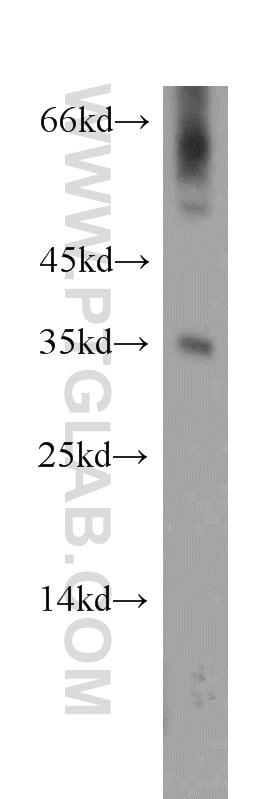DOK5 Polyklonaler Antikörper
DOK5 Polyklonal Antikörper für WB, ELISA
Wirt / Isotyp
Kaninchen / IgG
Getestete Reaktivität
human, Maus, Ratte
Anwendung
WB, ELISA
Konjugation
Unkonjugiert
Kat-Nr. : 11948-1-AP
Synonyme
Galerie der Validierungsdaten
Geprüfte Anwendungen
| Erfolgreiche Detektion in WB | Mauslebergewebe |
Empfohlene Verdünnung
| Anwendung | Verdünnung |
|---|---|
| Western Blot (WB) | WB : 1:500-1:2000 |
| It is recommended that this reagent should be titrated in each testing system to obtain optimal results. | |
| Sample-dependent, check data in validation data gallery | |
Produktinformation
11948-1-AP bindet in WB, ELISA DOK5 und zeigt Reaktivität mit human, Maus, Ratten
| Getestete Reaktivität | human, Maus, Ratte |
| Wirt / Isotyp | Kaninchen / IgG |
| Klonalität | Polyklonal |
| Typ | Antikörper |
| Immunogen | DOK5 fusion protein Ag2615 |
| Vollständiger Name | docking protein 5 |
| Berechnetes Molekulargewicht | 306 aa, 35 kDa |
| Beobachtetes Molekulargewicht | 35 kDa |
| GenBank-Zugangsnummer | BC008992 |
| Gene symbol | DOK5 |
| Gene ID (NCBI) | 55816 |
| Konjugation | Unkonjugiert |
| Form | Liquid |
| Reinigungsmethode | Antigen-Affinitätsreinigung |
| Lagerungspuffer | PBS mit 0.02% Natriumazid und 50% Glycerin pH 7.3. |
| Lagerungsbedingungen | Bei -20°C lagern. Nach dem Versand ein Jahr lang stabil Aliquotieren ist bei -20oC Lagerung nicht notwendig. 20ul Größen enthalten 0,1% BSA. |
Hintergrundinformationen
DOK5 belongs to the docking family of proteins that contain tandem pleckstrin homology-phosphotyrosine binding (PH-PTB) domains at their amino termini (PMID: 19909370). DOK proteins are also known as INS receptor substrates (IRS) and serve as substrates for INS and INS-like growth factor (PMID: 12730241 ) as well as various protein tyrosine kinases (PMID: 16647839). DOK5 functions as a specific signal transduction molecule and plays an important role in cellular differentiation. DOK5 is upregulated in systemic Sclerosis and Associated with IGFBP-5-Induced fibrosis (PMID: 24551065).
Protokolle
| Produktspezifische Protokolle | |
|---|---|
| WB protocol for DOK5 antibody 11948-1-AP | Protokoll herunterladen |
| Standard-Protokolle | |
|---|---|
| Klicken Sie hier, um unsere Standardprotokolle anzuzeigen |


